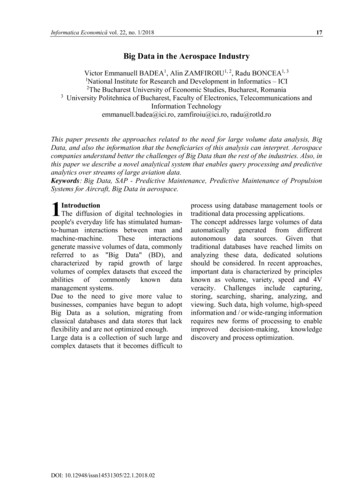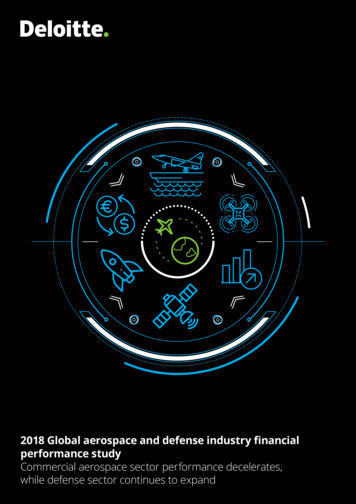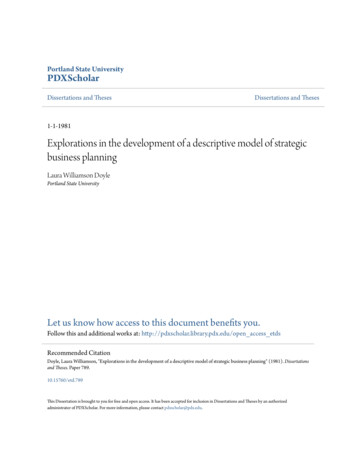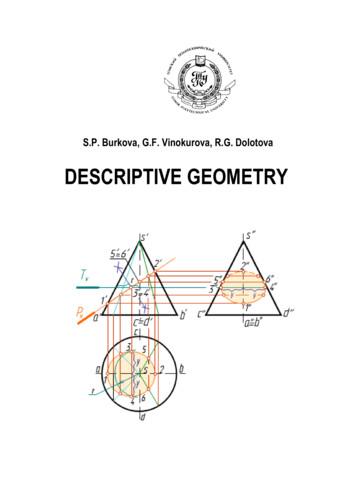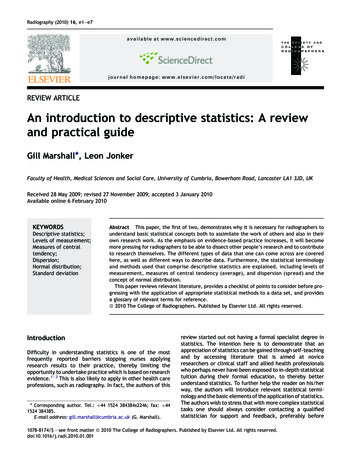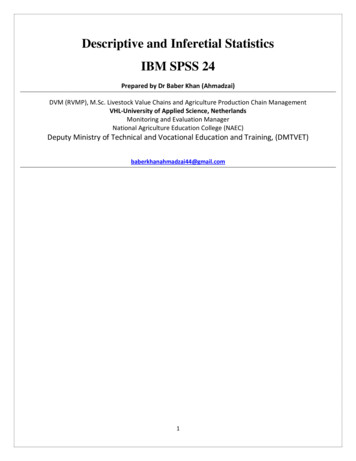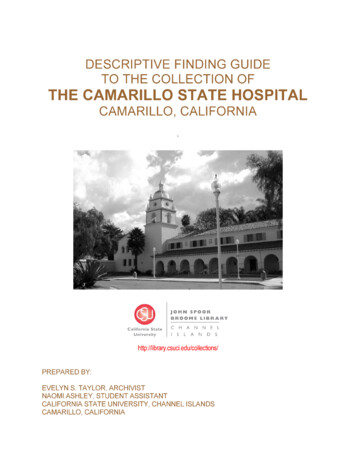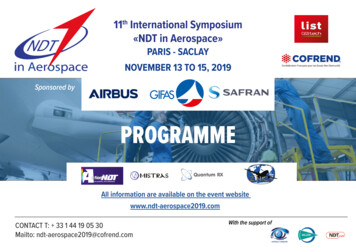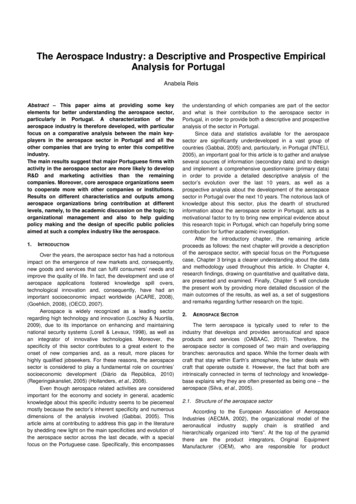
Transcription
The Aerospace Industry: a Descriptive and Prospective EmpiricalAnalysis for PortugalAnabela ReisAbstract – This paper aims at providing some keyelements for better understanding the aerospace sector,particularly in Portugal. A characterization of theaerospace industry is therefore developed, with particularfocus on a comparative analysis between the main keyplayers in the aerospace sector in Portugal and all theother companies that are trying to enter this competitiveindustry.The main results suggest that major Portuguese firms withactivity in the aerospace sector are more likely to developR&D and marketing activities than the remainingcompanies. Moreover, core aerospace organizations seemto cooperate more with other companies or institutions.Results on different characteristics and outputs amongaerospace organizations bring contribution at differentlevels, namely, to the academic discussion on the topic; toorganizational management and also to help guidingpolicy making and the design of specific public policiesaimed at such a complex industry like the aerospace.1.INTRODUCTIONOver the years, the aerospace sector has had a notoriousimpact on the emergence of new markets and, consequently,new goods and services that can fulfil consumers’ needs andimprove the quality of life. In fact, the development and use ofaerospace applications fostered knowledge spill overs,technological innovation and, consequently, have had animportant socioeconomic impact worldwide (ACARE, 2008),(Goehlich, 2008), (OECD, 2007).Aerospace is widely recognized as a leading sectorregarding high technology and innovation (Loschky & Nuortila,2009), due to its importance on enhancing and maintainingnational security systems (Lorell & Levaux, 1998), as well asan integrator of innovative technologies. Moreover, thespecificity of this sector contributes to a great extent to theonset of new companies and, as a result, more places forhighly qualified jobseekers. For these reasons, the aerospacesector is considered to play a fundamental role on countries’socioeconomic development (Diário da República, 2010)(Regeringskansliet, 2005) (Hollanders, et al., 2008).Even though aerospace related activities are consideredimportant for the economy and society in general, academicknowledge about this specific industry seems to be piecemealmostly because the sector’s inherent specificity and numerousdimensions of the analysis involved (Gabbai, 2005). Thisarticle aims at contributing to address this gap in the literatureby shedding new light on the main specificities and evolution ofthe aerospace sector across the last decade, with a specialfocus on the Portuguese case. Specifically, this encompassesthe understanding of which companies are part of the sectorand what is their contribution to the aerospace sector inPortugal, in order to provide both a descriptive and prospectiveanalysis of the sector in Portugal.Since data and statistics available for the aerospacesector are significantly underdeveloped in a vast group ofcountries (Gabbai, 2005) and, particularly, in Portugal (INTELI,2005), an important goal for this article is to gather and analyseseveral sources of information (secondary data) and to designand implement a comprehensive questionnaire (primary data)in order to provide a detailed descriptive analysis of thesector’s evolution over the last 10 years, as well as aprospective analysis about the development of the aerospacesector in Portugal over the next 10 years. The notorious lack ofknowledge about this sector, plus the dearth of structuredinformation about the aerospace sector in Portugal, acts as amotivational factor to try to bring new empirical evidence aboutthis research topic in Portugal, which can hopefully bring somecontribution for further academic investigation.After the introductory chapter, the remaining articleproceeds as follows: the next chapter will provide a descriptionof the aerospace sector, with special focus on the Portuguesecase, Chapter 3 brings a clearer understanding about the dataand methodology used throughout this article. In Chapter 4,research findings, drawing on quantitative and qualitative data,are presented and examined. Finally, Chapter 5 will concludethe present work by providing more detailed discussion of themain outcomes of the results, as well as, a set of suggestionsand remarks regarding further research on the topic.2.AEROSPACE SECTORThe term aerospace is typically used to refer to theindustry that develops and provides aeronautical and spaceproducts and services (OABAAC, 2010). Therefore, theaerospace sector is composed of two main and overlappingbranches: aeronautics and space. While the former deals withcraft that stay within Earth’s atmosphere, the latter deals withcraft that operate outside it. However, the fact that both areintrinsically connected in terms of technology and knowledgebase explains why they are often presented as being one – theaerospace (Silva, et al., 2005).2.1. Structure of the aerospace sectorAccording to the European Association of AerospaceIndustries (AECMA, 2002), the organizational model of theaeronautical industry supply chain is stratified andhierarchically organized into “tiers”. At the top of the pyramidthere are the product integrators, Original EquipmentManufacturer (OEM), who are responsible for product
2development and supply-chain management. Therefore, thesecompanies own the project and select the systems, structuresand major components suppliers, from the second tier. At thethird level one can find mainly a very concentrated group ofSmall and Medium Enterprises (SME) offering parts andcomponents assembled by tier 2 and sometimes even by tier 1firms. Even if these firms often get most of their revenues fromthe aerospace industry, they are also offering their productsand services to a large range of other industries.2.2. International ContextFor many decades, the US aerospace industry wasdominant worldwide. Today, the world civil market has evolvedinto the highly competitive duopoly of Boeing and theEuropean Aeronautic and Defence and Space Company(EADS).Looking at the top 100 aerospace companies in the world(ranked by sales) can provide a picture of the aerospace sectorperformance over the past 10 years, see Figure 1.Figure 2 - Aerospace sector turnover. Source: ASD Facts & Figures.Figure 2 shows that the aerospace industry had suffered fromthe effects of 11th September 2001, particularly the USaerospace industry. In 2004 there was a reversal of thisdownturn tendency and the aerospace sector experienced acontinued improvement through the following years. Althoughthe US aerospace sector had been strongly affected by theevents on September 11th, it has clearly recovered andmaintained its supremacy over the European aerospaceindustry. Despite the economic crises in the end of 2008, theEuropean and the US aerospace industry have slightlyincreased, which can be explained by the income of neworders.2.2.2. ExportsFigure 1 - Top 100 Aerospace Companies by location. Source:adapted from Flight International Magazine.Before proceeding, it is important to take into accountseveral factors, which have had an impact in the aerospacesector during the last decade: September 11 attacks have had a tremendous impactin the aerospace sector since it increase people’s fear offlying, leading to a reduced use of airlines fleets and,therefore, causing a decline in maintenance requirementsfrom airlines (Ito & Lee, 2004) (IATA, 2011); Deterioration of economic conditions due to thefinancial crisis in the end of 2008, which alongside with therise of the volatility in fuel prices led to the growingpressure in defence budgets. These factors havecontributed to an increasing search for efficiency, strongerpromotion of exports, more selective investments andrationalization of products portfolios (ASD, 2010) (IATA,2011).2.2.1. TurnoverFigure 2 depicts the US and the European aerospaceindustry turnover across the last decade.Aerospace exports are typically used as a major indicator ofcompetitiveness among the aerospace industry since it reflectsthe ability of countries to create and sustain high-skilled andhigh-wage jobs. It is equally or even more important torecognize that exports are necessary to sustain and increasethe capacity for cutting-edge innovation and to fund researchand development that will underpin next generation aerospacetechnology. Figure 3 shows the EU and US aerospace exportsevolution in the last decade, using ASD and AerospaceIndustries Association (AIA), as source to the EU and USexports respectively.Figure 3 - EU and US aerospace exports in millions . Source: ASDFacts & Figures.As shown in Figure 3, the European aerospace industry hasbeen reinforcing its position as a global actor serving marketsall over the world and overcoming the US after the financialcrises in 2008. As expected, the main downward was after the
3September 11, 2001, due to a greater fall in European exportsreflecting the difficulties incurred by the US airlines and thedownturn in the world economy. After 2004, exports startedrecovering from the 2001 downturn. However, if on the onehand the European industry reaching its higher point in 2010,due to the rise in export opportunities outside Europe (inparticular the Middle East and Asia), on the other hand the USexports have reached its highest point in 2008 and after thatexperienced a new decline. Since the US have the biggestdefence market, the US industry can still remain competitiveproducing to its internal market and without exporting.2.2.3. R&D ExpendituresInvestment in R&D, as well as in new programmes,education and skills provision is of foremost importance for thesustainability and development of a technology-intensiveindustry such as the aerospace. Figure 4 shows the Europeanand US R&D expenditure.Figure 4 - European and US R&D expenditure. Source: ASD Facts &after the September 11, 2001, followed by an ascendant trendafter 2003. However, with the financial meltdown of 2008, whilethe European workforce has remained slightly the same, beingmarginally affected by the crises, the US workforce hasdecreased. Additionally, since the turnover has increased inthis period of time, it is expected an increase in sectorproductivity.2.3. An outlook for Portugal2.3.1. Public PoliciesIn the last years, the governments’ approach to theaerospace industry has been marked by a change from directfinancial support to a stronger commercial relation. This hashappened due to the reduction of available budgets fordefence. Consequently, governments have encouragedmerges so that they can benefit from important synergies,which enable them to obtain higher values, lower costs,reducing the development costs and the associated risk.Therefore, the aerospace manufacturers have pursuedpartnerships and sharing of costs and development risks. Thisis important because the results, although solid, take long termdevelopment cycles. It is therefore crucial to define adequatepublic policies in order to assure stability in this sector. In thissense, the Portuguese government had taken two importantsteps in the last decade, namely: Portugal’s participation in European Space Agency (ESA)(November 2000); Portuguese Aeronautical Cluster Development (October2010).Figures, OECD and AIA.2.3.1.1. Portugal's Participation in ESAIt can be seen from Figure 4 that US R&D expenditure in theaerospace sector during the considered period of time hasbeen significantly higher than European expenditure. However,since 2008 there is no available data for the US investment inR&D and in within a context of financial crisis, the figures forthe US R&D expenditure might decrease significantly.2.2.1. EmploymentFigure 5 shows the number of employees for the US andEuropean aerospace sector.Space activities are characterized by their highly complex,multidisciplinary, technological and scientific challenging andinternational nature. Consequently, and similarly to whathappens in the European partners, whose activity in this sectorhave started long time ago, Portugal’s participation in spaceactivities can greatly benefit Portuguese society, as long asbased on clear decisions, reasonable funding levels andappropriate management. Therefore and, in accordance withthe R&D national strategy for space (2004), these benefits canbe translated in: internationalization, highly qualifiedemployment, knowledge transfer, social impact, nationalrecognition.2.3.1.2. Portuguese Aeronautical Cluster DevelopmentFigure 5 - EU and US aerospace number of employees. Source: ASDFacts & Figures.Alongside turnover, employment also presents a downwardThe Portuguese government has assumed the need todevelop a national aeronautical cluster in order to promotenational competencies and to integrate important aeronauticalproject supply chains. Therefore, in order to achieve this goal,the following tasks were defined by the Portuguese ministers’council (Diário da República, 2010):1.Promote the aggregation of the key playersassociated with the aeronautical cluster and boost the creationof new technological players in order to foster the evolution ofthe sector;2.Promote the growth and training of the national
4industrial and technological base, with special focus on thecreation of new technology-based companies; on the attractionof foreign investment and finally, on the consolidation of thisspecific cluster;3.Promote the effective, rational and completeutilization of the opportunities that arise from defenceacquisitions to develop the aeronautical sector.2.3.2. Market Structure and EvolutionThe leading Portuguese aerospace companies are OGMA –Indústria de Portugal, S.A. and TAP Maintenance andEngineering (TAP M&E). These two companies operate in theaeronautical sector, mainly in the maintenance field. In additionto these companies, there are several high qualified SMEs, aswell as small subsidiaries of international groups, positioned intier 3, which manufacture aerospace p
Looking at the top 100 aerospace companies in the world (ranked by sales) can provide a picture of the aerospace sector performance over the past 10 years, see Figure 1. recognize that exports are necessary to sustain and Figure 1 - Top 100 Aerospace Companies by location. Source: adapted from Flight International Magazine. Before proceeding, it is important to take into account several .
